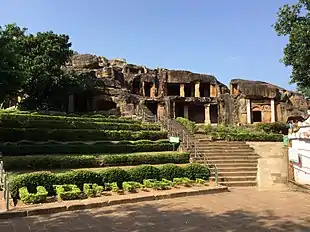
The Minor Inscriptions of Kharavela are the shorter inscriptions found near the major and celebrated Hathigumpha inscription of Kharavela in the twin hills of Udayagiri and Khandagiri Caves near Bhubanesvar, Odisha, India. These are inscribed on the walls or front of the caves in Brāhmī script and Prakrit language. They were published and deciphered by R. D. Banerji during the years 1915–16 (Epigraphic Indica – XIII).[1] Others such as B. M Barua (Indian Historical Quarterly-XIV) have also published their comments on these. These minor inscriptions mention the construction of caves for Jain monks during or during the decades following the reign of Kharavela (in or around 1st-century BCE).
Inscriptions
I: Mancapuri cave inscription (Upper storey)
This inscription is engraved on the raised space between the second and third doorways of the cave at Mancapuri. The text in Devanagari script is:
L.1: अरहंत पसादाय कलिंगानं समनानं लेनं कारितं राजिनो ललाकस (this is a transliteration in Devanagari of the original Brahmi)
L.2: हथिसिहस पपोतस धुतुना कलिंग चकवतिनो सिरिखारवेलस
L.3: अगमहिसिना कारितं
Translation: This temple of the Arahats (and) cave for the Sramanas of Kalinga has been made. It has been made by the chief queen of the illustrious Kharavela, the overlord of Kalinga, who was the daughter of King Lalaka – the grandson of Hastisahasa (or Hastisaha). (Translated by RD Banerji)[1]: 160
II and III: Mancapuri cave other inscriptions
These are found on the upper storey and lower storey, front wall.
- Upper secondary
(..ऐरस) महाराजस कलिंगाधिपतिना महामेघवाहनस कुदेपसिरिनो लेणं (this is a transliteration in Devanagari of the original Brahmi)
Translation: (This is) the cave of the clever, the King, Master of Kalinga, whose vehicle is the great cloud, Kudepasiri.[1]: 161
- lower storey
कुमारो वडुखस लेणं (IAST: kumāro vadukhas lenam) (this is a transliteration in Devanagari of the original Brahmi)
Translation: (This is) the cave of Prince Vaḍukha.[1]: 161
On paleographic grounds, R. D. Banerjee considered this inscription to pre-date the inscription of King Kudepasiri.
IV: Inscriptions in the Sarpagumpha (over doorway)
This inscription consisting of one line, is incised over the doorway of the Sarpagumpha. The text in Devanagari script is:
चूलकमस कोठाजेया च (IAST: cūlakamas koţhājeyā ca) (this is a transliteration in Devanagari of the original Brahmi)
Translation: The unsurpassable chamber of Chulakama[1]: 162
V: Inscription in the Sarpagumpha (left of doorway)
This is likely dated to the decades after Kaharvela's reign based on palaeography. The text of the engravings at the left of the doorway in Devanagari script is:
L.1: कंमस हलखि (this is a transliteration in Devanagari of the original Brahmi)
L.2: णय च पसादो
Translation: The temple (donated by) of Kamma and Halakhina.[1]: 162
The use of word Pasado (Sanskrit: Prasad) for temple is notable, as it is also found at the Mathura archaeological site.[1]: 162
VI: Haridas Cave inscription
This inscription contains one line has been incised over one of the three entrances to the main chamber of the cave from the veranda. The text in Devanagari script is:
चूलकमस पसातो कोठाजेया च (IAST: cūlakamas pasāto koţhājeyā ca) (this is a transliteration in Devanagari of the original Brahmi)
Translation: The temple and unsurpassable chamber of Chulakrama.[1]: 163
VII: Vyāghragumphā (Bagh Cave) Inscription
The record is incised on the outer wall of the inner chamber. The text in Devanagari script is:
L.1: नगर अखंदस (this is a transliteration in Devanagari of the original Brahmi)
L.2: स भूतिनो लेणं
Translation: The cave of the town-judge Sabhuti (Subhuti).[1]: 163
VIII: Jambesavara cave inscription
This inscription has been engraved over the entrances to the inner chamber of the cave. The text in Devanagari script is:
महादस बरयाय नकियस लेनं (this is a transliteration in Devanagari of the original Brahmi)
Translation: The cave of Nākiya, wife of Mahamada.[1]: 164
X: Tatowāgumphā inscription (Cave No 1)
The record of this inscription is incised over one of the entrances to the inner chamber. The text in Sanskrit reads as:
पादमुलिकस कुसुमस लेणं x [॥] (IAST: pādamulikas kusumas lenam x) (this is a transliteration in Devanagari of the original Brahmi)
Translation: The cave of Kusuma, the servant of (or an inhabitant of Padamulika).[1]: 164
There is a syllable after the word lenam marked "x" above, may be read as ni or phi and appears superfluous.[1]: 164
XI: Ananta Gumpha inscription (A)
The record is incised on the architrave between the left ante and the fifth pillar. The text in Devanagari script is:
दोहद समणनं लेणं (this is a transliteration in Devanagari of the original Brahmi)
Translation: The cave of the monks of Dohada.[1]: 165
Other inscriptions
The caves have a painted inscription in Tatwagumpha from between 100 BCE to 100 CE, which is largely lost other than some characters such as "na", "ta", "tha" "da", "dha", "na" ..... "pa pha ba..." that appear to recite the traditional Indian alphabet over and over again.[1]: 164–166 Smaller fragments of Brahmi inscription exist elsewhere. In the Navamuni cave, two inscriptions from the 10th or 11th-century CE are found. Similarly others caves have Jaina inscriptions in poor quality Sanskrit.[1]: 164–168
References
- Kant, Shashi (2000). The Hathigumpha Inscription of Kharavela and the Bhabru Edict of Ashoka. D K Printworld Pvt. Ltd.
- Mahajan, Malati (2003). "Orissa". Place Names in Inscriptions C. 260 BC–1200 AD (Cultural and Historical Geography). Sundeep Prakashan.